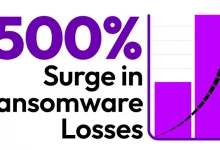You settle into your cozy armchair for a movie night, your smart lights dimming automatically as you fire up the projector. As the opening credits roll, you reach for your phone to order popcorn, only to be met with a chilling notification: “Unauthorized access detected on your smart kitchen appliances.”
Your blood runs cold as you scramble to disconnect everything from the internet, the once comforting hum of your smart home now a menacing drone.
This isn’t a scene from a dystopian sci-fi thriller, but a potential reality in the age of smart homes. While these interconnected devices promise convenience and luxury, they also introduce a new frontier of vulnerabilities: smart home cybersecurity risks.
From eavesdropping smart speakers to hacked thermostats, the very things designed to make our lives easier can become gateways for unwanted intrusions. This isn’t paranoia; it’s a stark reality. Research from Zscaler ThreatLabz paints a chilling picture: a staggering 400% surge in IoT malware attacks in the first half of 2023 alone, compared to the previous year.
As we step into the age of hyper-connected homes, understanding smart home cybersecurity threats and safeguarding our digital sanctuaries is more crucial than ever.
In this article, we’ll delve into the dark side of smart homes, exposing the hidden security threats lurking in our everyday devices. We’ll explore the common vulnerabilities, the potential consequences of cyberattacks, and most importantly, the practical steps you can take to fortify your smart home against digital invaders.
So, before you plug in that next smart gadget, read on this critical exploration of the smart home cybersecurity risks in everyday devices. Because in the age of smart homes, cybersecurity is no longer optional, it’s essential.
Safe Homes, Smart Homes: A Cybersecurity Deep Dive
Operating under the expansive umbrella of the Internet of Things (IoT), smart home devices, from thermostats to security cameras, bring automation and remote control to home management.
Yet, as we embrace the advantages of these interconnected technologies, it becomes paramount to grasp the critical importance of smart home cybersecurity. Specifically, devices like cameras and printers, designed for connectivity, inadvertently serve as potential entry points for cyber threats.
Illuminated by striking statistics, the initial two months of 2023 witnessed a weekly average of 54% of organizations facing targeted attacks—a significant 41% surge from 2022. With nearly 60 attacks per organization per week on IoT devices, this marks a tripling of incidents compared to two years prior. The spectrum of targeted devices spans common IoT elements, including routers, IP cameras, DVRs, NVRs, and printers.
Notably, IoT devices like speakers and IP cameras, integral to remote work and learning setups, offer cybercriminals an extensive array of potential entry points. Therefore, understanding the intricate dynamics of smart home cybersecurity emerges as a crucial imperative in our quest for a secure and connected future.
Smart Home Devices and their Vulnerabilities
Smart Security Cameras
Smart security cameras, designed to enhance home surveillance, unfortunately, expose users to various cybersecurity risks ranging from unauthorized access to data decryption in IoT cameras. In 2022, vulnerabilities in at least five models of EZVIZ IoT cameras came to light, allowing threat actors to potentially access, decrypt, and download video footage.
As a globally used brand offering numerous IoT security camera models, EZVIZ faced scrutiny from cybersecurity analysts at Bitdefender, who identified these vulnerabilities, highlighting the broader concerns in IoT hardware security.
The unsettling incidents extend beyond EZVIZ, as Xiaomi Mijia’s smart security cameras also faced scrutiny. Reports emerged of vulnerabilities that allowed unauthorized access to camera feeds, leading to concerns about user privacy.
Notably, a Google Nest Hub owner discovered images from other users’ homes appearing randomly on his camera feed, highlighting the potential risks associated with smart security devices.
Even established brands like Ring, a subsidiary of Amazon, have grappled with cybersecurity challenges, leading to a class-action lawsuit. Instances of unauthorized access and hacking incidents on Ring’s security cameras prompted heightened scrutiny.
Notably, Bitdefender researchers identified a flaw in Amazon’s Ring Video Doorbell Pro, potentially granting hackers unauthorized access to the user’s Wi-Fi network and other connected devices. While a security patch has been deployed to address the issue, it highlights the inherent vulnerability of widely used smart security systems.
Moreover, in March 2023, Ring reportedly fell victim to an alleged data breach orchestrated by the ALPHV ransomware group. While there is no official confirmation of the Amazon Ring data breach, a news report uncovered that the ransomware group claims to possess access to the home security company’s private data and has issued threats to disclose it unless an agreement is reached.
The compromised data potentially encompasses sensitive information such as mailing addresses, phone numbers, passwords, and more. The Cyber Express has reached out to Amazon Ring for comment on the incident but is still awaiting a response.
Similarly, Tenable researchers uncovered seven critical vulnerabilities in Amazon’s Blink XT2 security camera systems, including the ability for hackers to remotely view camera footage, listen to audio, and launch DDoS attacks. Amazon responded by promptly releasing patches and urging users to update their devices to mitigate the identified vulnerabilities.
These incidents collectively highlight the critical need to address and rectify cybersecurity risks associated with smart security cameras, safeguarding user privacy and safety.
Smart TV
The surge in Over-The-Top (OTT) platform use has led to a significant increase in Smart TV purchases, with an expected value of US$340.8 billion by 2027. Android TV, developed by Google, has experienced rapid growth, doubling its device count annually since 2016, now surpassing 80 million devices.
Despite the convenience of Smart TVs storing passwords for various services, especially for popular platforms like Google, Amazon Prime, and Netflix, they face cybersecurity risks.
Smart TVs, particularly those using protocols like DIAL, have been vulnerable. A bug in Netflix’s screencast protocol, known as DIALStranger, allowed hackers to manipulate video streams, revealing the potential for credential theft. Purdue University researchers also found vulnerabilities in Smart TVs, enabling attackers to control and access stored data. Google responded to a related vulnerability (CVE-2021-0889) on their Android TV platform.
Historical instances, such as the 2019 discovery of vulnerabilities in Sony’s Android-based smart TVs, including their flagship Bravia line, highlighted risks like compromising WiFi passwords and accessing stored images.
The FBI has warned about overlooked security issues in smart TVs, emphasizing manufacturers’ neglect of security considerations, making these devices susceptible to various threats.
These vulnerabilities extend beyond homes to impact companies and organizations using smart TVs in conference and meeting rooms, broadening the threat surface. As Smart TV adoption rises, addressing and fortifying against diverse cybersecurity risks associated with these devices becomes crucial.
Smart Bulbs
While smart lights eliminate the need for traditional switches, offering convenient home automation, they too fall prey to cybersecurity risks. Murtuza Jadliwala from the University of Texas at San Antonio reveals a potential vulnerability where hackers can compromise infrared-enabled smart bulbs by exploiting infrared invisible light emitted from the bulbs.
This manipulation allows attackers to send commands, potentially compromising other connected IoT devices within the home network.
In August 2023, TP-Link’s Tapo smart light bulbs gained popularity for their affordability compared to competitors like Philips Hue. However, recent research uncovered vulnerabilities in both the bulbs and the Tapo app, creating an opportunity for hackers to pilfer the Wi-Fi password of the home network.
The most significant issue arises from a lack of authentication between the smart bulb and the Tapo app, allowing attackers to impersonate a smart bulb and authenticate to the application.
Another substantial vulnerability involves a hardcoded, short shared secret exposed by code fragments. The remaining issues, rated as ‘medium’ severity, pertain to message transmissions between the app and the smart bulb, using static initialization vectors and lacking freshness checks for received messages.
Exploiting these vulnerabilities could enable attackers within the smart bulb’s range to access Tapo credentials and Wi-Fi credentials. While the first vulnerability requires the smart bulb to be in setup mode for exploitation, the second vulnerability can be exploited if the bulb is already connected, necessitating users to reset the bulb.
These findings highlight the importance of addressing cybersecurity vulnerabilities in smart bulbs to safeguard the security of connected home networks.
Smart Speakers
Smart speakers, a common fixture in modern households for their convenience, raise cybersecurity concerns as users must place trust in the companies handling their voice recordings and ambient sounds. This vulnerability isn’t exclusive to specific brands, even extending to Google Home smart speakers.
Researchers from the University of Texas at San Antonio (UTSA) and the University of Colorado at Colorado Springs (UCCS) have uncovered a noteworthy sensitivity in most smart speakers. These devices, capable of picking up voice commands beyond the conventional frequency range of human voices, present a potential risk of unintended eavesdropping.
In 2019, security researchers at SRLabs brought to light a substantial vulnerability affecting both Google and Amazon smart speakers. This flaw could empower hackers to covertly eavesdrop on users or execute phishing attacks.
The researchers demonstrated the risk by disguising malicious software as seemingly innocuous Alexa skills or Google actions, illustrating the potential for smart speakers to surreptitiously record users or solicit sensitive information, such as Google account passwords.
This revelation serves as a crucial reminder for users to exercise prudence with third-party software associated with voice assistants. Diligence in monitoring and removing unused or unnecessary applications is vital to mitigate potential security risks, ensuring the privacy and security of smart speaker users.
Cracking the Code: Risks Affecting Smart Devices
The susceptibility of smart devices to cyberattacks stems from a combination of factors, each contributing to a complex web of vulnerabilities. Weak passwords, often chosen for their simplicity, serve as a gateway for unauthorized access, compounded by the lack of encryption that leaves data vulnerable to interception.
The landscape of data privacy concerns deepens with the monetization of personal data, prompting ethical questions about the collection practices employed by smart devices. The inadequacy of data protection measures further exposes user privacy, leaving personal information at risk.
Device vulnerabilities introduce another layer of risk, where outdated software and firmware create exploitable security gaps. “
Numerous smart devices exhibit vulnerabilities in their software or firmware that hackers can exploit, potentially leading to unauthorized access, control, or manipulation of the device,” said Rami F. Khawaly, R&D Manager, MindoLife IoT. The delayed implementation of security updates exacerbates this risk, leaving devices exposed to known vulnerabilities.
Additionally, Khawaly highlighted that insecure networks, characterized by weak or poorly configured Wi-Fi setups, serve as significant gateways for cybercriminals to compromise smart home devices. “Weak or poorly configured Wi-Fi networks serve as gateways for cybercriminals to access smart home devices. Strengthening network security is imperative,” he explained.
Mehul Doshi, CTO at Jainam Technologies, sheds light on the critical role of edge security, especially in the context of home devices reliant on wireless or home gateway connections.
“Presently majority of the home devices are connected via wireless, or home gateway, and edge security become as strong as the edge parameters or capability. Indian Corporate and Consumer industry Broadband at home is just started to move upward interest and cellular broadband has been the weak link as well as strength. The reason is the IP pool be it IPv4 or IPv6,” explained Doshi.
The dynamic nature of the IP pool, coupled with the OEM nature of devices and a deficiency in lifecycle updates, creates an environment ripe for cyber threats. As users prioritize migrating to newer edge devices over maintaining or upgrading firmware, smart home devices become attractive targets for BOT operators.
“We have seen massive scans taking place by varied BOT operators attempting to identify the common weakness or vulnerability. A small brand like Zyxel was the reason for the edge vulnerability exploit in Denmark and India has many such devices in its base. Smart Home devices’ second concern is the TLS session and authorization session for management,” Doshi highlighted further.
As the smart home ecosystem expands, a collective commitment to staying ahead of cybersecurity challenges is crucial to ensuring the seamless integration of technology without compromising privacy and security.
Smart Moves for a Secure Smart Home
Securing your smart home against the dark side of cybersecurity risks demands a strategic and vigilant approach. Strengthening passwords and incorporating robust authentication processes is akin to fortifying the entrance, and preventing unauthorized access to your smart devices.
Regularly updating software and firmware is the digital equivalent of installing security reinforcements, patching vulnerabilities, and ensuring the latest defenses are in place.
“Ensure that IoT devices have the capability to upgrade firmware over the air (OTA). This functionality must be highly secure to prevent potential exploitation by attackers attempting to inject malicious code, said Khawaly.
Think of it as a routine checkup for your smart home’s health.
Ensuring the resilience of your home network is equally crucial. Much like securing the perimeter of a physical space, fortifying Wi-Fi setups is essential to thwart unauthorized infiltrations. For instance, adopting advanced encryption protocols, such as WPA3, enhances the security posture of your network.
“Smart homes today are Digital Box with too many digital attack surfaces exposed. The biggest threat comes from CCTV cameras fire alarms and door locks. These devices have both digital and physical impacts such as breach of privacy, life threats, etc.
It is important to scan and check the security settings and posture of these devices since they do not have any inbuilt anti-virus support Manufacturers must publish the possibility of security threats due to unprotected smart home devices, so that users are aware of risks,” opined Divyanshu Verma, Chief Executive Officer, Redinent Innovation.
Further, education has become a powerful weapon in this cybersecurity arsenal. Raising awareness and educating users about potential risks and best practices empowers them to recognize and respond to potential threats. It’s like providing homeowners with a manual on smart living, enabling them to navigate the digital landscape safely.
Consider the concept of local data storage as an additional layer of security. By reducing reliance on cloud-based services and minimizing the exposure of sensitive information, you limit potential attack surfaces. It’s akin to keeping valuable possessions in a secure safe within your home rather than entrusting them to an external storage facility.
“Discourage the use of technologies that upload and store data in any cloud. Given the sensitivity and value of collected data, it should be stored locally in a gateway and maintained there. This approach ensures that users retain control over their data,” said Khawaly.
To streamline the implementation of these security measures, consider the role of widely adopted IoT platforms. These platforms, such as Apple’s HomeKit or Google’s SmartThings, come equipped with built-in security features.
Choosing devices that align with such platforms ensures that your smart home is not just connected but also fortified against evolving cyber threats. As you fortify your smart home, remember that a proactive and comprehensive strategy ensures a resilient and secure digital living space.
Securing Smart Homes Without Sacrificing Convenience
In this exciting era of smart homes, we’re surfing the wave of convenience, letting our homes adapt and respond to our every need. Yet, amidst this tech-driven thrill, it’s crucial to recognize the delicate dance between convenience and security.
As we bask in the glow of automation, ensuring our digital fortresses stand strong becomes a personal mission. We shouldn’t let the fear of cyberattacks cripple our enjoyment of the smart home’s many benefits. Instead, let’s view security as an investment, a necessary step to ensure that our havens of comfort remain truly safe.
Think of it like installing a sturdy lock on your door – it doesn’t prevent you from enjoying your home, but it gives you peace of mind knowing you’re protected.
Ultimately, the future of the smart home lies in our hands. By embracing a security-conscious approach, we can ensure that these interconnected devices continue to enrich our lives without compromising our safety.
In this digital adventure, let’s not just chase the ease of living but also safeguard the very essence of what makes a home—a place of comfort, privacy, and security. Finding that perfect balance is the real smart move in the smart home game.





